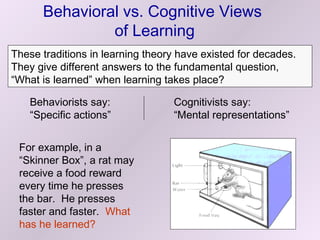
Behavioral vs. cognitive views of learning
- 1. Behavioral vs. Cognitive Views of Learning These traditions in learning theory have existed for decades. They give different answers to the fundamental question, “What is learned” when learning takes place? Behaviorists say: Cognitivists say: “Specific actions” “Mental representations” For example, in a “Skinner Box”, a rat may receive a food reward every time he presses the bar. He presses faster and faster. What has he learned?
- 2. Behavioral vs. Cognitive Views of Learning These traditions in learning theory have existed for decades. They give different answers to the fundamental question, “What is learned” when learning takes place? Behaviorists say: Cognitivists say: “to press the bar.” “that pressing produces food.” For example, in a “Skinner Box”, a rat may receive a food reward every time he presses the bar. He presses faster and faster. What has he learned?
- 3. Behavioral vs. Cognitive Views of Learning Behaviorism (“learns to”) 1. Learning involves the formation of associations between specific actions and specific events (stimuli) in the environment. These stimuli may either precede or follow the action (antecedents vs. consequences). 2. Many behaviorists use intervening variables to explain behavior (e.g., habit, drive) but avoid references to mental states. 3. RADICAL BEHAVIORISM (operant conditioning/behavior modification/behavior analysis): avoids any intervening variables and focuses on descriptions of relationships between behavior and environment (“functional analysis”).
- 4. Behavioral vs. Cognitive Views of Learning Cognitivism (“learns that”) 1. Learning takes place in the mind, not in behavior. It involves the formation of mental representations of the elements of a task and the discovery of how these elements are related. 2. Behavior is used to make inferences about mental states but is not of interest in itself (“methodological behaviorism”). 3. EXAMPLE: Tolman & Honzik’s experiment on latent learning. Tolman, a pioneer of cognitive psychology, argued that when rats practice mazes, they acquire a “cognitive map” of the layout—mental representations of the landmarks and their spatial relationships.
- 5. Response Vs. Place Learning (Tolman, Ritchie & Kalish, 1946) Start 2 This maze had no walls or roof so that rats could see “landmarks” in the room such as a window, door, or lamp. On a random half of the trials, the rats started from Start Goal 2 Goal 1 Box 1, and on the other half they started from Start Box 2. Start 1 GROUP P always found food in Goal Box 1. GROUP R found food in Goal Box 1 when they started from Start Box 1 but received food in Goal Box 2 when they started from Start Box 2.
- 6. Response Vs. Place Learning (Tolman, Ritchie & Kalish, 1946) Start 2 Cognitive theory predicted that GROUP P would learn faster because they only had to learn one cognitive map. Behavior theory predicted GROUP R would learn faster Goal 2 Goal 1 because they only had to learn one sequence of movements at the choice point—a right turn. Start 1 GROUP P always found food in Goal Box 1. GROUP R found food in Goal Box 1 when they started from Start Box 1 but received food in Goal Box 2 when they started from Start Box 2.
- 7. Response Vs. Place Learning (Tolman, Ritchie & Kalish, 1946) Start 2 What’s YOUR prediction? Are you a behaviorist or a cognitivist? GROUP GROUP P R Goal 2 Goal 1 Start 1 GROUP P always found food in Goal Box 1. GROUP R found food in Goal Box 1 when they started from Start Box 1 but received food in Goal Box 2 when they started from Start Box 2.
- 8. Response Vs. Place Learning (Tolman, Ritchie & Kalish, 1946) Start 2 What’s YOUR prediction? Are you a behaviorist or a cognitivist? GROUP GROUP P R Group P learned faster. But Goal 2 Goal 1 Later studies found that if the maze had a roof so the rats couldn’t see things in the room, response learning was faster. Start 1 GROUP P always found food in Goal Box 1. GROUP R found food in Goal Box 1 when they started from Start Box 1 but received food in Goal Box 2 when they started from Start Box 2.
- 9. Response Vs. Place Learning (Tolman, Ritchie & Kalish, 1946) Start 2 What’s YOUR prediction? Are you a behaviorist or a cognitivist? GROUP GROUP P R Group P learned faster. Goal 2 Goal 1 Both response and place learning occur. Which type is faster depends on what cues are available. So both the cognitive and behavioral views turned out to be right! Start 1 GROUP P always found food in Goal Box 1. GROUP R found food in Goal Box 1 when they started from Start Box 1 but received food in Goal Box 2 when they started from Start Box 2.
